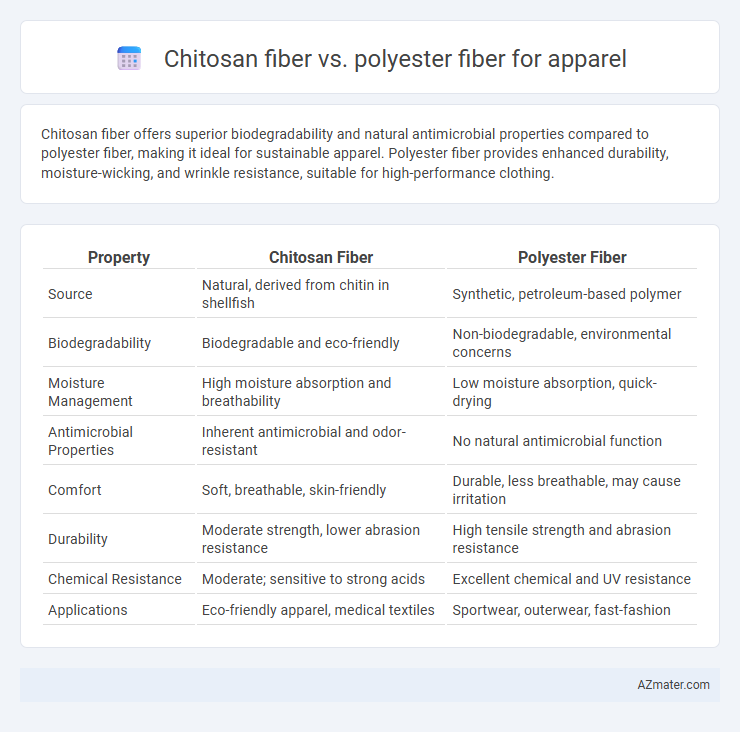Chitosan fiber offers superior biodegradability and natural antimicrobial properties compared to polyester fiber, making it ideal for sustainable apparel. Polyester fiber provides enhanced durability, moisture-wicking, and wrinkle resistance, suitable for high-performance clothing.
Table of Comparison
| Property | Chitosan Fiber | Polyester Fiber |
|---|---|---|
| Source | Natural, derived from chitin in shellfish | Synthetic, petroleum-based polymer |
| Biodegradability | Biodegradable and eco-friendly | Non-biodegradable, environmental concerns |
| Moisture Management | High moisture absorption and breathability | Low moisture absorption, quick-drying |
| Antimicrobial Properties | Inherent antimicrobial and odor-resistant | No natural antimicrobial function |
| Comfort | Soft, breathable, skin-friendly | Durable, less breathable, may cause irritation |
| Durability | Moderate strength, lower abrasion resistance | High tensile strength and abrasion resistance |
| Chemical Resistance | Moderate; sensitive to strong acids | Excellent chemical and UV resistance |
| Applications | Eco-friendly apparel, medical textiles | Sportwear, outerwear, fast-fashion |
Introduction to Chitosan and Polyester Fibers
Chitosan fiber, derived from the natural polysaccharide chitosan found in crustacean shells, offers biodegradability, antimicrobial properties, and excellent moisture absorption, making it a sustainable option for eco-friendly apparel. Polyester fiber, a synthetic polymer made from petroleum-based products, provides high durability, wrinkle resistance, and quick-drying capabilities, commonly used in mass-produced garments. Comparing these fibers highlights chitosan's environmental benefits and functional bioactivity versus polyester's strength and easy-care attributes in textile applications.
Fiber Origin and Production Process
Chitosan fiber originates from natural sources by extracting chitosan from crustacean shells, followed by a spinning process that converts the biopolymer into fibers, emphasizing eco-friendly and biodegradable characteristics. Polyester fiber is a synthetic material derived from petrochemical polymers, produced through melt spinning of polyethylene terephthalate (PET), offering durability and moisture resistance but relying on non-renewable resources. The production of chitosan fiber involves biological extraction and chemical modification, contrasting with the energy-intensive, chemical polymerization process used for polyester fiber manufacturing.
Physical and Mechanical Properties Comparison
Chitosan fiber exhibits superior biodegradability and antibacterial properties compared to polyester fiber, making it an eco-friendly choice for sustainable apparel. Physically, chitosan fiber offers excellent moisture absorption and breathability, whereas polyester fiber excels in durability, tensile strength, and wrinkle resistance. Mechanically, polyester fibers provide higher elasticity and resilience, maintaining shape retention under stress, while chitosan fibers have moderate tensile strength but benefit from enhanced comfort and skin-friendliness.
Comfort and Wearability in Apparel
Chitosan fiber offers superior moisture absorption and breathability compared to polyester fiber, enhancing comfort and reducing skin irritation in apparel. Its natural antibacterial properties help maintain freshness and prevent odor, making it ideal for prolonged wear and sensitive skin. Polyester fiber, while durable and wrinkle-resistant, tends to trap heat and moisture, which can lead to discomfort during extended use.
Moisture Management and Breathability
Chitosan fiber demonstrates superior moisture management by effectively absorbing and releasing sweat, creating a dry and comfortable microclimate during physical activity. Its natural breathability outperforms polyester fiber, enhancing ventilation and reducing heat retention in apparel applications. The biodegradability and antimicrobial properties of chitosan further contribute to improved hygiene and freshness compared to synthetic polyester textiles.
Antimicrobial and Hypoallergenic Qualities
Chitosan fiber exhibits superior antimicrobial properties due to its natural ability to inhibit bacterial growth, making it highly suitable for apparel requiring enhanced hygiene. Its hypoallergenic qualities result from its biocompatibility and non-toxic nature, reducing the risk of skin irritation compared to synthetic polyester fiber. Polyester fiber, while durable and moisture-wicking, lacks inherent antimicrobial and hypoallergenic features, often necessitating chemical treatments to achieve similar effects.
Environmental Impact and Biodegradability
Chitosan fiber, derived from chitin found in crustacean shells, offers superior environmental benefits due to its biodegradability and renewable source, significantly reducing landfill waste and microplastic pollution compared to polyester fiber. Polyester, a synthetic polymer made from petrochemicals, contributes to environmental degradation through high carbon emissions during production and persistent microplastic shedding during washing. The biodegradable nature of chitosan fiber facilitates its natural decomposition, promoting sustainable apparel solutions, whereas polyester fibers can take hundreds of years to break down, posing long-term ecological challenges.
Durability and Maintenance Requirements
Chitosan fiber offers moderate durability with natural antimicrobial properties that reduce odor and bacterial growth, making it suitable for activewear and sensitive skin. Polyester fiber provides superior durability, resistance to stretching, shrinking, and abrasion, which makes it ideal for heavy-use apparel and frequent washing cycles. Maintenance for chitosan fiber requires gentle washing to preserve its bioactive qualities, whereas polyester fibers are low-maintenance, quick-drying, and colorfast.
Cost Implications for Manufacturers and Consumers
Chitosan fiber typically incurs higher production costs than polyester fiber due to its natural origin and complex extraction process, impacting manufacturers' pricing strategies. Polyester fiber, derived from petroleum, benefits from established mass-production economies, making it more cost-effective for large-scale apparel manufacturing. Consumers often face higher retail prices for garments with chitosan fiber, attributed to its biodegradability and antimicrobial properties, while polyester apparel offers affordability and durability.
Future Trends and Market Potential in Apparel Industry
Chitosan fiber, derived from natural biopolymers, offers eco-friendly benefits such as biodegradability, antimicrobial properties, and breathability, positioning it as a sustainable alternative to synthetic polyester fiber in the apparel industry. Market trends indicate growing consumer demand for green textiles and regulatory pressures on plastic microfibers are accelerating investment and innovation in chitosan fiber production technologies. While polyester remains dominant due to cost-effectiveness and durability, chitosan fiber's expanding applications in antimicrobial clothing and high-performance sportswear signify strong future growth potential aligned with sustainable fashion initiatives.

Infographic: Chitosan fiber vs Polyester fiber for Apparel
 azmater.com
azmater.com